Answered step by step
Verified Expert Solution
Question
1 Approved Answer
What were the worst mistakes made by Globestelle during the production development proces ? Please explain step by step. The Reltex Project Nigel Slack Globestelle
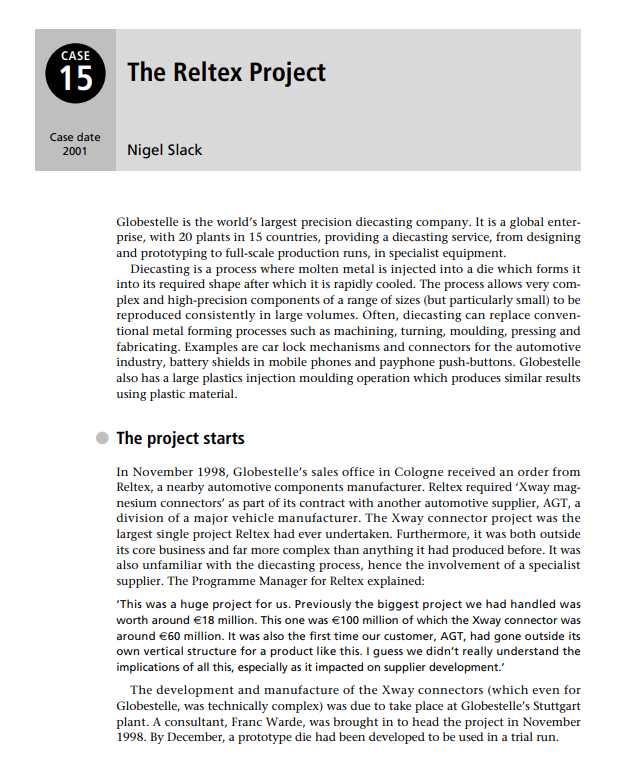
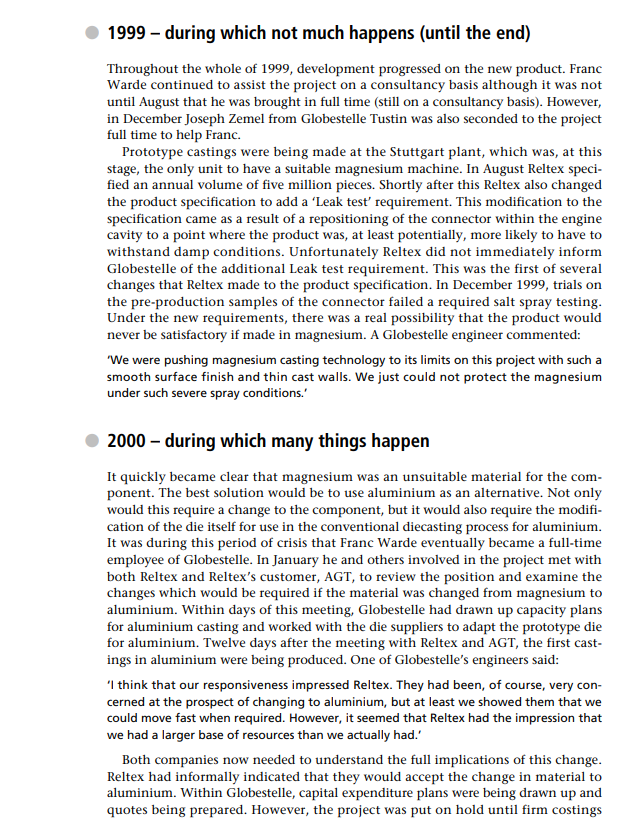
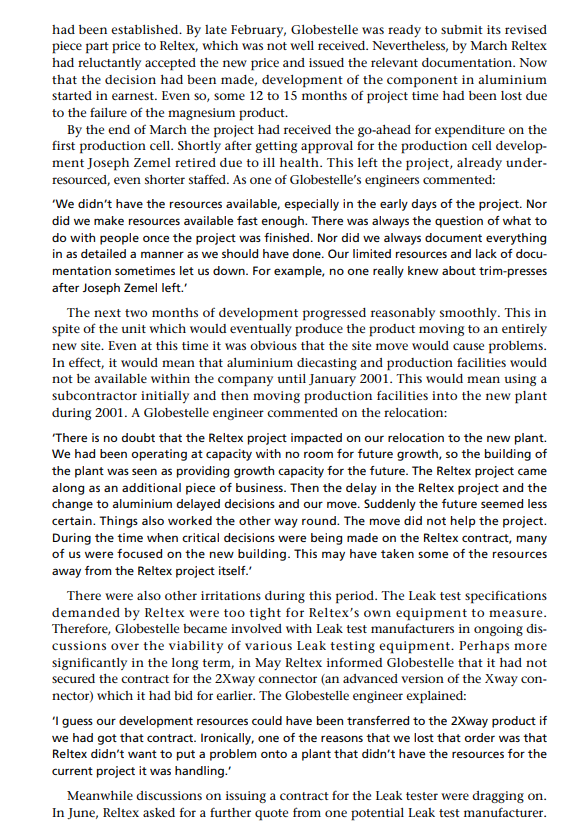
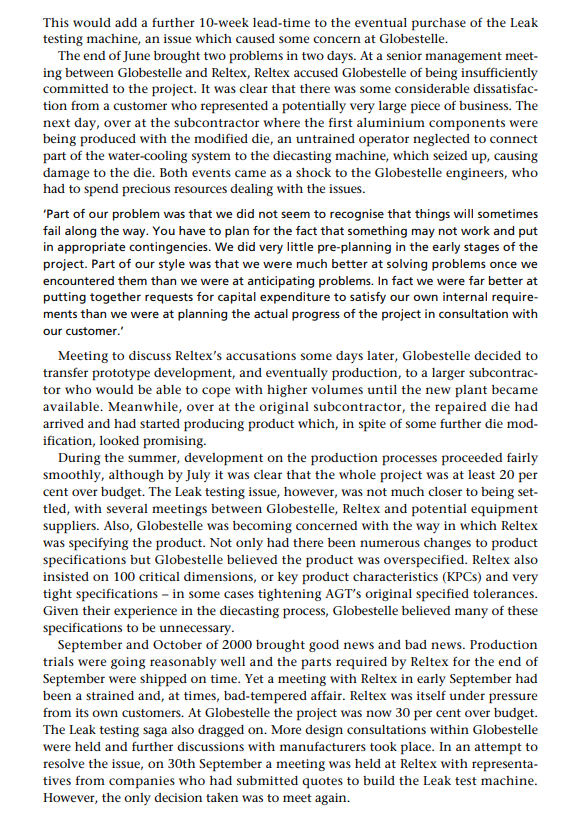
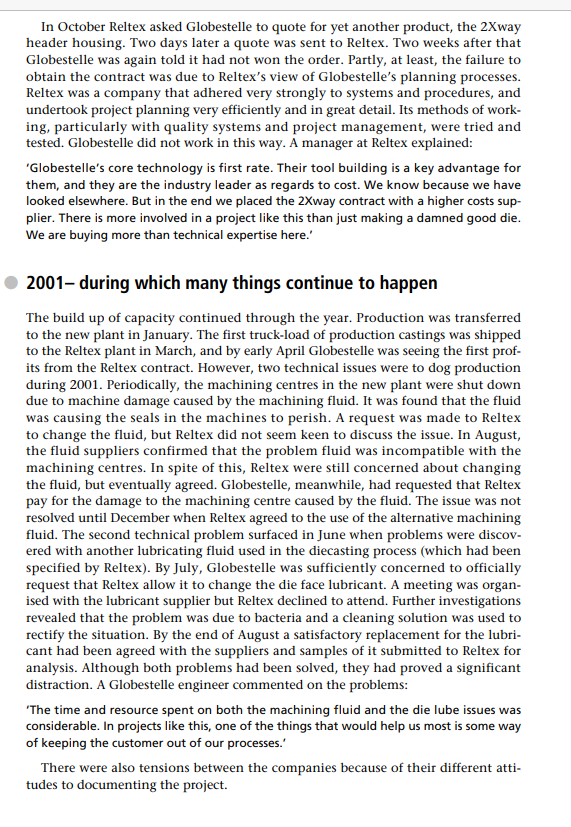
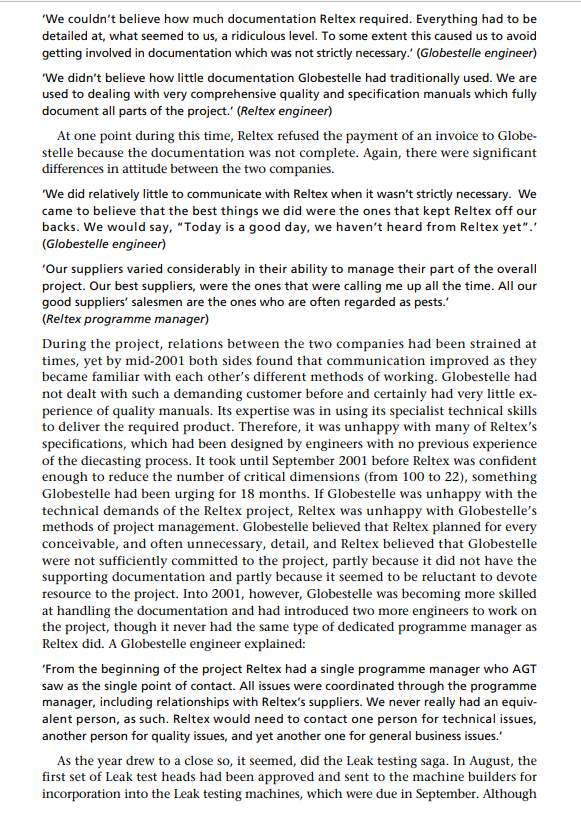

What were the worst mistakes made by Globestelle during the production development proces ?
Please explain step by step.
The Reltex Project Nigel Slack Globestelle is the world's largest precision diecasting company. It is a global enterprise, with 20 plants in 15 countries, providing a diecasting service, from designing and prototyping to full-scale production runs, in specialist equipment. Diecasting is a process where molten metal is injected into a die which forms it into its required shape after which it is rapidly cooled. The process allows very complex and high-precision components of a range of sizes (but particularly small) to be reproduced consistently in large volumes. Often, diecasting can replace conventional metal forming processes such as machining, turning, moulding, pressing and fabricating. Examples are car lock mechanisms and connectors for the automotive industry, battery shields in mobile phones and payphone push-buttons. Globestelle also has a large plastics injection moulding operation which produces similar results using plastic material. The project starts In November 1998, Globestelle's sales office in Cologne received an order from Reltex, a nearby automotive components manufacturer. Reltex required 'Xway magnesium connectors' as part of its contract with another automotive supplier, AGT, a division of a major vehicle manufacturer. The Xway connector project was the largest single project Reltex had ever undertaken. Furthermore, it was both outside its core business and far more complex than anything it had produced before. It was also unfamiliar with the diecasting process, hence the involvement of a specialist supplier. The Programme Manager for Reltex explained: 'This was a huge project for us. Previously the biggest project we had handled was worth around 18 million. This one was 100 million of which the Xway connector was around 60 million. It was also the first time our customer, AGT, had gone outside its own vertical structure for a product like this. I guess we didn't really understand the implications of all this, especially as it impacted on supplier development.' The development and manufacture of the Xway connectors (which even for Globestelle, was technically complex) was due to take place at Globestelle's Stuttgart plant. A consultant, Franc Warde, was brought in to head the project in November 1998. By December, a prototype die had been developed to be used in a trial run. 1999 - during which not much happens (until the end) Throughout the whole of 1999, development progressed on the new product. Franc Warde continued to assist the project on a consultancy basis although it was not until August that he was brought in full time (still on a consultancy basis). However, in December Joseph Zemel from Globestelle Tustin was also seconded to the project full time to help Franc. Prototype castings were being made at the Stuttgart plant, which was, at this stage, the only unit to have a suitable magnesium machine. In August Reltex specified an annual volume of five million pieces. Shortly after this Reltex also changed the product specification to add a 'Leak test' requirement. This modification to the specification came as a result of a repositioning of the connector within the engine cavity to a point where the product was, at least potentially, more likely to have to withstand damp conditions. Unfortunately Reltex did not immediately inform Globestelle of the additional Leak test requirement. This was the first of several changes that Reltex made to the product specification. In December 1999, trials on the pre-production samples of the connector failed a required salt spray testing. Under the new requirements, there was a real possibility that the product would never be satisfactory if made in magnesium. A Globestelle engineer commented: 'We were pushing magnesium casting technology to its limits on this project with such a smooth surface finish and thin cast walls. We just could not protect the magnesium under such severe spray conditions.' 2000 - during which many things happen It quickly became clear that magnesium was an unsuitable material for the component. The best solution would be to use aluminium as an alternative. Not only would this require a change to the component, but it would also require the modification of the die itself for use in the conventional diecasting process for aluminium. It was during this period of crisis that Franc Warde eventually became a full-time employee of Globestelle. In January he and others involved in the project met with both Reltex and Reltex's customer, AGT, to review the position and examine the changes which would be required if the material was changed from magnesium to aluminium. Within days of this meeting, Globestelle had drawn up capacity plans for aluminium casting and worked with the die suppliers to adapt the prototype die for aluminium. Twelve days after the meeting with Reltex and AGT, the first castings in aluminium were being produced. One of Globestelle's engineers said: 'I think that our responsiveness impressed Reltex. They had been, of course, very concerned at the prospect of changing to aluminium, but at least we showed them that we could move fast when required. However, it seemed that Reltex had the impression that we had a larger base of resources than we actually had.' Both companies now needed to understand the full implications of this change. Reltex had informally indicated that they would accept the change in material to aluminium. Within Globestelle, capital expenditure plans were being drawn up and quotes being prepared. However, the project was put on hold until firm costings had been established. By late February, Globestelle was ready to submit its revised piece part price to Reltex, which was not well received. Nevertheless, by March Reltex had reluctantly accepted the new price and issued the relevant documentation. Now that the decision had been made, development of the component in aluminium started in earnest. Even so, some 12 to 15 months of project time had been lost due to the failure of the magnesium product. By the end of March the project had received the go-ahead for expenditure on the first production cell. Shortly after getting approval for the production cell development Joseph Zemel retired due to ill health. This left the project, already underresourced, even shorter staffed. As one of Globestelle's engineers commented: 'We didn't have the resources available, especially in the early days of the project. Nor did we make resources available fast enough. There was always the question of what to do with people once the project was finished. Nor did we always document everything in as detailed a manner as we should have done. Our limited resources and lack of documentation sometimes let us down. For example, no one really knew about trim-presses after Joseph Zemel left.' The next two months of development progressed reasonably smoothly. This in spite of the unit which would eventually produce the product moving to an entirely new site. Even at this time it was obvious that the site move would cause problems. In effect, it would mean that aluminium diecasting and production facilities would not be available within the company until January 2001. This would mean using a subcontractor initially and then moving production facilities into the new plant during 2001. A Globestelle engineer commented on the relocation: 'There is no doubt that the Reltex project impacted on our relocation to the new plant. We had been operating at capacity with no room for future growth, so the building of the plant was seen as providing growth capacity for the future. The Reltex project came along as an additional piece of business. Then the delay in the Reltex project and the change to aluminium delayed decisions and our move. Suddenly the future seemed less certain. Things also worked the other way round. The move did not help the project. During the time when critical decisions were being made on the Reltex contract, many of us were focused on the new building. This may have taken some of the resources away from the Reltex project itself.' There were also other irritations during this period. The Leak test specifications demanded by Reltex were too tight for Reltex's own equipment to measure. Therefore, Globestelle became involved with Leak test manufacturers in ongoing discussions over the viability of various Leak testing equipment. Perhaps more significantly in the long term, in May Reltex informed Globestelle that it had not secured the contract for the 2Xway connector (an advanced version of the Xway connector) which it had bid for earlier. The Globestelle engineer explained: I guess our development resources could have been transferred to the 2 Xway product if we had got that contract. Ironically, one of the reasons that we lost that order was that Reltex didn't want to put a problem onto a plant that didn't have the resources for the current project it was handling.' Meanwhile discussions on issuing a contract for the Leak tester were dragging on. In June, Reltex asked for a further quote from one potential Leak test manufacturer. This would add a further 10-week lead-time to the eventual purchase of the Leak testing machine, an issue which caused some concern at Globestelle. The end of June brought two problems in two days. At a senior management meeting between Globestelle and Reltex, Reltex accused Globestelle of being insufficiently committed to the project. It was clear that there was some considerable dissatisfaction from a customer who represented a potentially very large piece of business. The next day, over at the subcontractor where the first aluminium components were being produced with the modified die, an untrained operator neglected to connect part of the water-cooling system to the diecasting machine, which seized up, causing damage to the die. Both events came as a shock to the Globestelle engineers, who had to spend precious resources dealing with the issues. 'Part of our problem was that we did not seem to recognise that things will sometimes fail along the way. You have to plan for the fact that something may not work and put in appropriate contingencies. We did very little pre-planning in the early stages of the project. Part of our style was that we were much better at solving problems once we encountered them than we were at anticipating problems. In fact we were far better at putting together requests for capital expenditure to satisfy our own internal requirements than we were at planning the actual progress of the project in consultation with our customer.' Meeting to discuss Reltex's accusations some days later, Globestelle decided to transfer prototype development, and eventually production, to a larger subcontractor who would be able to cope with higher volumes until the new plant became available. Meanwhile, over at the original subcontractor, the repaired die had arrived and had started producing product which, in spite of some further die modification, looked promising. During the summer, development on the production processes proceeded fairly smoothly, although by July it was clear that the whole project was at least 20 per cent over budget. The Leak testing issue, however, was not much closer to being settled, with several meetings between Globestelle, Reltex and potential equipment suppliers. Also, Globestelle was becoming concerned with the way in which Reltex was specifying the product. Not only had there been numerous changes to product specifications but Globestelle believed the product was overspecified. Reltex also insisted on 100 critical dimensions, or key product characteristics (KPCs) and very tight specifications - in some cases tightening AGT's original specified tolerances. Given their experience in the diecasting process, Globestelle believed many of these specifications to be unnecessary. September and October of 2000 brought good news and bad news. Production trials were going reasonably well and the parts required by Reltex for the end of September were shipped on time. Yet a meeting with Reltex in early September had been a strained and, at times, bad-tempered affair. Reltex was itself under pressure from its own customers. At Globestelle the project was now 30 per cent over budget. The Leak testing saga also dragged on. More design consultations within Globestelle were held and further discussions with manufacturers took place. In an attempt to resolve the issue, on 30th September a meeting was held at Reltex with representatives from companies who had submitted quotes to build the Leak test machine. However, the only decision taken was to meet again. In October Reltex asked Globestelle to quote for yet another product, the 2Xway header housing. Two days later a quote was sent to Reltex. Two weeks after that Globestelle was again told it had not won the order. Partly, at least, the failure to obtain the contract was due to Reltex's view of Globestelle's planning processes. Reltex was a company that adhered very strongly to systems and procedures, and undertook project planning very efficiently and in great detail. Its methods of working, particularly with quality systems and project management, were tried and tested. Globestelle did not work in this way. A manager at Reltex explained: 'Globestelle's core technology is first rate. Their tool building is a key advantage for them, and they are the industry leader as regards to cost. We know because we have looked elsewhere. But in the end we placed the 2Xway contract with a higher costs supplier. There is more involved in a project like this than just making a damned good die. We are buying more than technical expertise here.' 2001- during which many things continue to happen The build up of capacity continued through the year. Production was transferred to the new plant in January. The first truck-load of production castings was shipped to the Reltex plant in March, and by early April Globestelle was seeing the first profits from the Reltex contract. However, two technical issues were to dog production during 2001. Periodically, the machining centres in the new plant were shut down due to machine damage caused by the machining fluid. It was found that the fluid was causing the seals in the machines to perish. A request was made to Reltex to change the fluid, but Reltex did not seem keen to discuss the issue. In August, the fluid suppliers confirmed that the problem fluid was incompatible with the machining centres. In spite of this, Reltex were still concerned about changing the fluid, but eventually agreed. Globestelle, meanwhile, had requested that Reltex pay for the damage to the machining centre caused by the fluid. The issue was not resolved until December when Reltex agreed to the use of the alternative machining fluid. The second technical problem surfaced in June when problems were discovered with another lubricating fluid used in the diecasting process (which had been specified by Reltex). By July, Globestelle was sufficiently concerned to officially request that Reltex allow it to change the die face lubricant. A meeting was organised with the lubricant supplier but Reltex declined to attend. Further investigations revealed that the problem was due to bacteria and a cleaning solution was used to rectify the situation. By the end of August a satisfactory replacement for the lubricant had been agreed with the suppliers and samples of it submitted to Reltex for analysis. Although both problems had been solved, they had proved a significant distraction. A Globestelle engineer commented on the problems: 'The time and resource spent on both the machining fluid and the die lube issues was considerable. In projects like this, one of the things that would help us most is some way of keeping the customer out of our processes.' There were also tensions between the companies because of their different attitudes to documenting the project. 'We couldn't believe how much documentation Reltex required. Everything had to be detailed at, what seemed to us, a ridiculous level. To some extent this caused us to avoid getting involved in documentation which was not strictly necessary.' (Globestelle engineer) 'We didn't believe how little documentation Globestelle had traditionally used. We are used to dealing with very comprehensive quality and specification manuals which fully document all parts of the project.' (Reltex engineer) At one point during this time, Reltex refused the payment of an invoice to Globestelle because the documentation was not complete. Again, there were significant differences in attitude between the two companies. 'We did relatively little to communicate with Reltex when it wasn't strictly necessary. We came to believe that the best things we did were the ones that kept Reltex off our backs. We would say, "Today is a good day, we haven't heard from Reltex yet".' (Globestelle engineer) 'Our suppliers varied considerably in their ability to manage their part of the overall project. Our best suppliers, were the ones that were calling me up all the time. All our good suppliers' salesmen are the ones who are often regarded as pests.' (Reltex programme manager) During the project, relations between the two companies had been strained at times, yet by mid-2001 both sides found that communication improved as they became familiar with each other's different methods of working. Globestelle had not dealt with such a demanding customer before and certainly had very little experience of quality manuals. Its expertise was in using its specialist technical skills to deliver the required product. Therefore, it was unhappy with many of Reltex's specifications, which had been designed by engineers with no previous experience of the diecasting process. It took until September 2001 before Reltex was confident enough to reduce the number of critical dimensions (from 100 to 22), something Globestelle had been urging for 18 months. If Globestelle was unhappy with the technical demands of the Reltex project, Reltex was unhappy with Globestelle's methods of project management. Globestelle believed that Reltex planned for every conceivable, and often unnecessary, detail, and Reltex believed that Globestelle were not sufficiently committed to the project, partly because it did not have the supporting documentation and partly because it seemed to be reluctant to devote resource to the project. Into 2001, however, Globestelle was becoming more skilled at handling the documentation and had introduced two more engineers to work on the project, though it never had the same type of dedicated programme manager as Reltex did. A Globestelle engineer explained: 'From the beginning of the project Reltex had a single programme manager who AGT saw as the single point of contact. All issues were coordinated through the programme manager, including relationships with Reltex's suppliers. We never really had an equivalent person, as such. Reltex would need to contact one person for technical issues, another person for quality issues, and yet another one for general business issues.' As the year drew to a close so, it seemed, did the Leak testing saga. In August, the first set of Leak test heads had been approved and sent to the machine builders for incorporation into the Leak testing machines, which were due in September. Although initially repeatability and reliability tests proved disappointing, by October the Leak testing equipment was finally available for use. Two months later, Reltex informed Globestelle that Leak testing was 'no longer deemed critical' and should be 'put on the back burner' for the time beingStep by Step Solution
There are 3 Steps involved in it
Step: 1

Get Instant Access to Expert-Tailored Solutions
See step-by-step solutions with expert insights and AI powered tools for academic success
Step: 2

Step: 3

Ace Your Homework with AI
Get the answers you need in no time with our AI-driven, step-by-step assistance
Get Started


